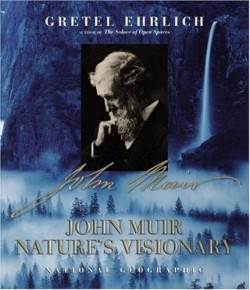
John Muir
Nature's Visionary
Most people know little about John Muir. A good beginning place to remedy that is this compelling look at a complex man of contradictions, great strength of character, and an endless love of nature.
Muir, Scottish by birth, spent his early boyhood in Dunbar with an evangelical, controlling father and daily beatings, but still a place of refuge in the countryside. When John was ten, Daniel Muir abandoned a comfortable situation in Dunbar to seek another life in America; they sailed in 1849.
Things didn’t improve for young Muir. His harsh father worked children and livestock alike to their limits, practically starving his children, keeping the Wisconsin house heatless in winter, working a horse to death in summer. Despite it all, Muir found joy in the outdoors, finally leaving home to pursue his own dreams.
He always carried within him a deep reverence for the natural world, but he also had a talent for making mechanical devices and improving industrial production. This conflict between things natural and man-made bothered him until, after a factory accident that nearly blinded him, he abandoned the mechanistic world altogether and “answered the call of the wild.”
There were other contradictions in Muir’s life. He loved his family and being with people, but was happiest wandering the Sierras, exploring glaciers in Alaska, or watching ouzels in the wild. He hated politics, yet late in life took on some of the most powerful forces in the country to preserve his beloved Sierras. He found it difficult to write, but produced eloquent pleas on behalf of the natural world he cared about so passionately.
One hundred photographs of wonderful variety present the glaciers, falls, and woods Muir loved, as well as glimpses of his life: his wife Louise, his children, the house where he was born, the farm where he grew up, his glacier expeditions.
Overall, it is an impressive book. It falls short of magnificence for two reasons. First, some photos would benefit from closer placement to the relating text. Second, the writer knows so much about Muir that she occasionally speaks from knowledge the reader does not share. This makes for tantalizing but unfulfilled glimpses into a fascinating past.
Perhaps this is not a disservice after all, because learning more about the man who so loved the world’s wild places could do nothing but good in this time of environmental concern.
Reviewed by
Marlene Satter
Disclosure: This article is not an endorsement, but a review. The publisher of this book provided free copies of the book to have their book reviewed by a professional reviewer. No fee was paid by the publisher for this review. Foreword Reviews only recommends books that we love. Foreword Magazine, Inc. is disclosing this in accordance with the Federal Trade Commission’s 16 CFR, Part 255.
